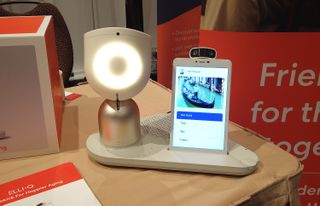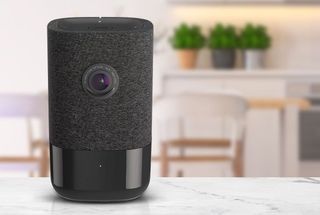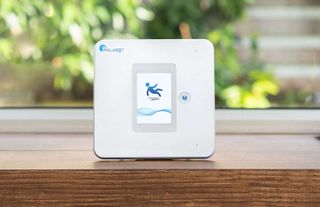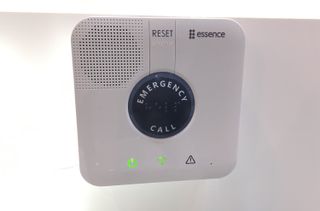These Smart Home Devices Use AI to Keep Tabs on the Elderly
Smart home devices augmented with artificial intelligence can track a person's movement throughout the home, and to send out an alert if anything is amiss.
LAS VEGAS — As smart home devices grow in sophistication, they're also becoming more specialized to meet the needs of specific types of people. One of the trends we're seeing here at CES is smart home gadgets and systems designed for the elderly, which use a combination of sensors and artificial intelligence to track a person's movement throughout the home, and send out an alert if anything is amiss.
ElliQ

One of the more peculiar devices we saw is the ElliQ, a robotic companion, which has a "head" that lights up and moves in a human-like fashion when talking to a person. Also using an AI, it will proactively suggest actions for the person, such as when they need to take their pills, go for a walk, or play music if there are guests over. The ElliQ also has several cameras built in to detect a person's presence, but they also let the user video-chat with family members. It isn't cheap, though. The ElliQ, available for pre-order, costs $1,499 plus a $35-per-month subscription. (The company will waive the first year's subscription fee for those who pre-order).
Alarm.com

Alarm.com's new Wellcam is a smart speaker of sorts, with a motion detector and a 1080p camera in the front. A button on the top lets a person initiate a voice or video call with a family member who has the Alarm.com app on their smartphone or tablet. However, the motion sensor also records the daily habits of the person — such as the time they usually wake up — and can notify a caretaker if there's a change in the pattern. The Wellcam is meant to be purchased by someone who already has professional monitoring from Alarm.com, and who wants to extend the service to their elderly parent's house.
Walabot

Along the same lines, the Walabot is a square device that mounts to a wall, and uses radio waves to detect a person's presence. Currently, this $149 device (there's also a $4.99 monthly subscription) can send out an alert only if it senses when someone falls. But the company is refining its algorithms to detect general behavior patterns, so it will also be able to sense when there's a change in a person's routine. The Walabot has a small touchscreen display, speaker and mic, so that you can talk to a person through an app.
Essence Care@Home

Essence's Care@Home system has a wall-mounted box used for communication, as well as a wearable button that detects a person's movement. Along with other motion sensors, the system monitors a person's movement and establishes a profile. If there's a deviation from that, it will then notify an emergency contact. In addition, the wearable button can also detect falls and, when the wearer is out of the house, will connect to their smartphone via Bluetooth if an incident occurs.
Hive Link

Hive, the maker of a suite of smart home devices, is debuting the Hive Link, which collects data from the various Hive sensors in a person's home to form a baseline pattern of that person's behavior. It then can send an alert when something changes, or when that person forgets to lock their front door. The service is debuting in the UK, where it will cost £15 a month ($19.15), plus a one-time charge of £150 ($191).
Pillo

Lastly, the Pillo is a device whose AI can ensure that a person takes their medicine. It has a friendly — but somewhat creepy — circular face, behind which is a carousel that can hold up to a month's worth of pills in separate containers. After you program the Pillo with information about when you need to take your pills, the device will wake up before the appointed time and give you a reminder. Built into the face of the Pillo is a camera that has two purposes. The first is face detection, meaning it will dispense pills only when the approved person sits in front of the device. Second, the camera can be used to video chat with a family member, to whom Pillo can send an alert if the user has not received their pills. As with the other products mentioned here, there's a cost both for the hardware ($499), and the monthly subscription fee: $39.
Artificial intelligence has been one of the big buzzwords at CES this year, and while many of its applications have been for flashier things, such as autonomous vehicles and smart TVs, it's interesting to see it being used for a market that's only going to grow in size as baby boomers get older. While many of the things we saw demonstrate that this is still a nascent technology, we're curious to see where it leads.
Sign up to get the BEST of Tom’s Guide direct to your inbox.
Upgrade your life with a daily dose of the biggest tech news, lifestyle hacks and our curated analysis. Be the first to know about cutting-edge gadgets and the hottest deals.

Michael A. Prospero is the U.S. Editor-in-Chief for Tom’s Guide. He oversees all evergreen content and oversees the Homes, Smart Home, and Fitness/Wearables categories for the site. In his spare time, he also tests out the latest drones, electric scooters, and smart home gadgets, such as video doorbells. Before his tenure at Tom's Guide, he was the Reviews Editor for Laptop Magazine, a reporter at Fast Company, the Times of Trenton, and, many eons back, an intern at George magazine. He received his undergraduate degree from Boston College, where he worked on the campus newspaper The Heights, and then attended the Columbia University school of Journalism. When he’s not testing out the latest running watch, electric scooter, or skiing or training for a marathon, he’s probably using the latest sous vide machine, smoker, or pizza oven, to the delight — or chagrin — of his family.
